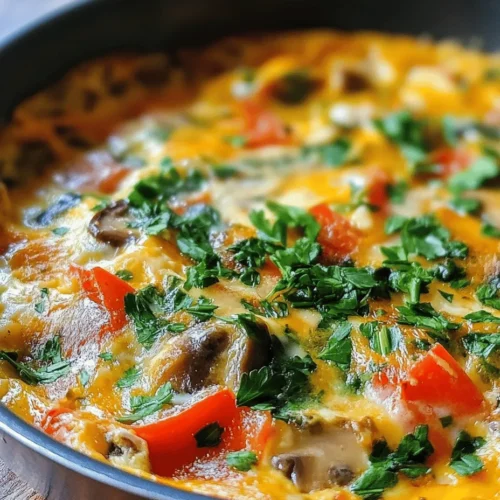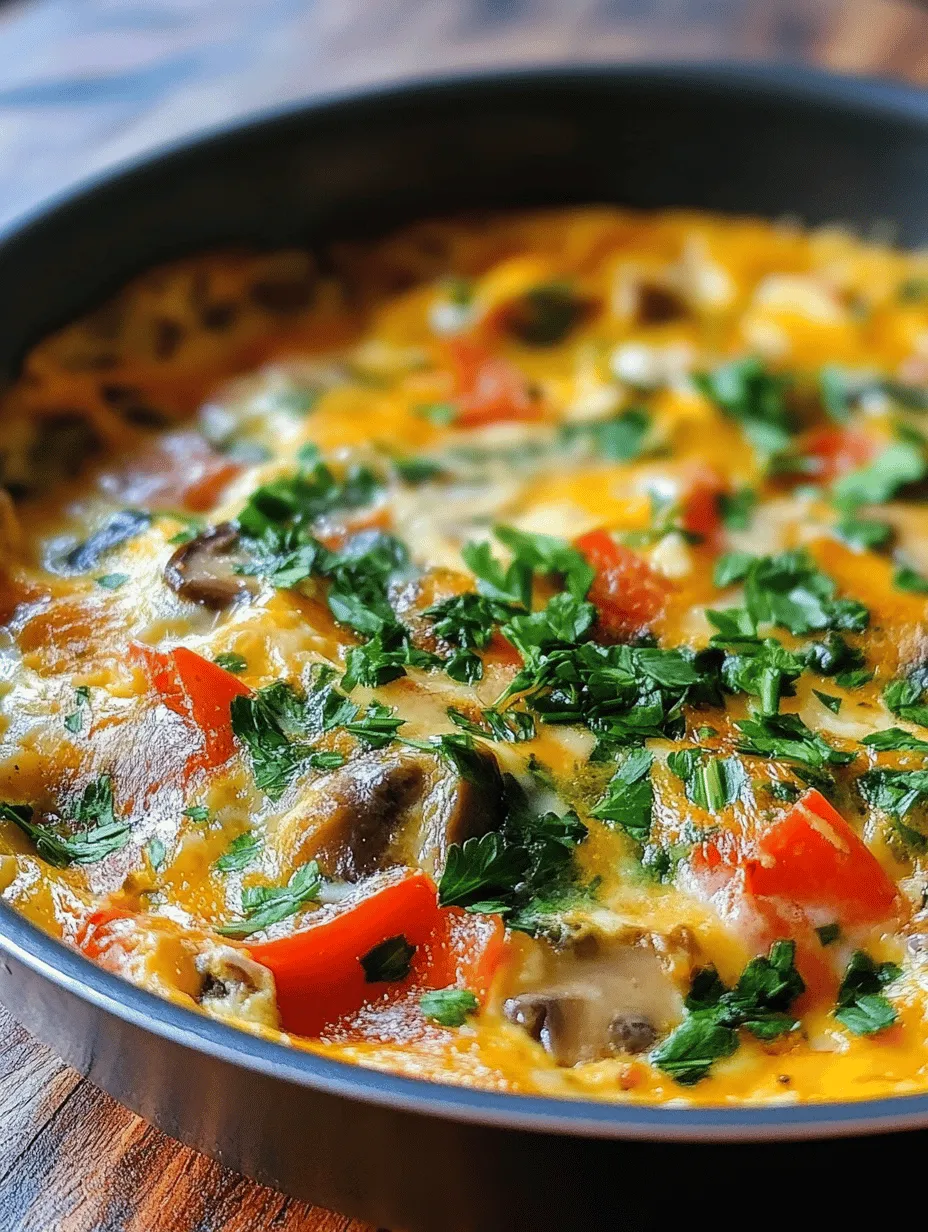Introduction
Frittatas are a beloved staple in kitchens around the world, known for their versatility and ease of preparation. This Italian dish, often enjoyed for breakfast, brunch, or even dinner, is essentially a baked egg dish that can be filled with an array of vegetables, meats, and cheeses. The beauty of the frittata lies in its adaptability; it can be customized to suit any palate or dietary preference, making it a perfect choice for family meals or gatherings.
Incorporating a variety of vegetables into your meals is crucial for maintaining a healthy diet. Not only do they provide essential vitamins and minerals, but they also add vibrant colors and textures that can make even the simplest dishes more visually appealing and satisfying. The Colorful Veggie Frittata stands out as a nutritious and eye-catching option, packed with a rainbow of vegetables that not only enhance its aesthetics but also boost its health benefits. Furthermore, this recipe can easily accommodate different dietary needs; whether you’re using dairy or plant-based milk, this frittata can be tailored to fit your lifestyle.
Understanding Frittatas: A Culinary Delight
To truly appreciate the Colorful Veggie Frittata, it’s important to understand what a frittata is and how it differs from similar egg-based dishes. Originating from Italy, the term “frittata” translates to “fried” in English, but this dish is more than just fried eggs. A traditional frittata is made by cooking eggs slowly over low heat, often in a skillet, before being finished in the oven. This method allows the eggs to set without becoming rubbery, resulting in a tender and custard-like texture.
Frittatas are often compared to omelets and quiches, but there are distinct differences among them. Unlike omelets, which are typically folded over fillings and cooked quickly, frittatas are stirred with the ingredients and cooked more slowly, giving them a thicker consistency. Quiches, on the other hand, are baked in a pastry crust and usually contain a custard made from eggs and cream. Frittatas, being crustless, are less labor-intensive and can be made in one pan, making them a convenient option for home cooks.
In terms of nutrition, frittatas offer a wealth of benefits. Eggs are an excellent source of protein, containing all nine essential amino acids, making them a complete protein source. They’re also rich in vitamins such as B12, riboflavin, and selenium. By incorporating colorful vegetables into the frittata, you not only enhance its nutritional profile but also introduce a variety of antioxidants and phytochemicals that promote overall health.
Ingredients Breakdown
A well-made frittata begins with high-quality ingredients. For the Colorful Veggie Frittata, the main components include:
– Eggs: The foundation of the dish, eggs provide structure and protein.
– Colorful vegetables: Bell peppers, mushrooms, and spinach are excellent choices, each bringing unique flavors and nutritional benefits.
– Cheese: A touch of cheese can enhance the flavor and creaminess of the frittata, making it more satisfying.
– Fresh herbs: Adding herbs like parsley or chives not only elevates the flavor but also adds a burst of freshness.
Nutritional Value of Eggs
Eggs are nutrient-dense and versatile, making them a wonderful addition to any meal. Each large egg contains about 6 grams of protein and is packed with essential nutrients such as vitamin D, choline, and omega-3 fatty acids. The yolk, in particular, contains most of the vitamins and minerals found in eggs, making it an important part of the dish. Additionally, eggs are relatively low in calories, which makes them an excellent choice for those looking to maintain a healthy weight.
Benefits of Incorporating Colorful Vegetables
The vibrant vegetables in this frittata not only make it visually appealing but also contribute significantly to its health benefits.
– Bell Peppers: Rich in vitamin C, bell peppers add sweetness and crunch. They are also high in antioxidants, which can help protect your body from oxidative stress.
– Mushrooms: These fungi are low in calories but high in fiber and essential minerals like selenium. They enhance the umami flavor of the frittata, giving it depth.
– Spinach: A powerhouse of nutrients, spinach is loaded with vitamins A, C, and K, as well as iron and calcium. Its mild flavor complements the other ingredients beautifully.
The Role of Cheese in Flavor and Texture
While optional, cheese can elevate the frittata, adding richness and a wonderful creaminess. Cheddar, feta, or goat cheese are popular choices that melt beautifully and enhance the overall flavor profile. Cheese also contributes calcium and protein, making the frittata even more nutritious.
Significance of Fresh Herbs as a Garnish
Fresh herbs are the finishing touch that can transform a good frittata into a great one. They add a layer of freshness and complexity to the dish. Chopped parsley, basil, or chives can be sprinkled on top just before serving, brightening the flavors and offering an inviting aroma that is sure to entice everyone at the table.
Preparation Steps Explained
Creating a Colorful Veggie Frittata begins with some essential preparation steps that set the foundation for a delicious dish.
Preheating the Oven
Before you start mixing ingredients, it’s vital to preheat your oven. The recommended temperature for baking a frittata is around 375°F (190°C). Preheating ensures that the frittata cooks evenly, allowing it to puff up perfectly while retaining a soft texture. An oven that is not adequately heated can lead to uneven cooking, resulting in a frittata that is undercooked in some areas and overcooked in others.
Sautéing Vegetables
Sautéing the vegetables is a crucial step in maximizing their flavor and texture. Begin by heating a small amount of oil or butter in an oven-safe skillet over medium heat. Once hot, add your chopped vegetables and cook until they are softened and slightly caramelized. This process not only enhances their natural sweetness but also allows them to release their moisture, preventing the frittata from becoming soggy.
When selecting vegetables, consider their cooking times. For instance, denser vegetables like bell peppers might take a bit longer to sauté than softer vegetables like spinach. It’s best to add the denser vegetables first, allowing them to cook for a few minutes before adding the softer ones.
Tips for Selecting and Preparing Vegetables
When preparing your colorful veggie frittata, freshness is key. Choose vibrant, firm vegetables that are in season for the best flavor and nutritional content. Wash and chop them into uniform sizes to ensure even cooking. You can also experiment with different vegetables based on what’s available or your personal preferences. Zucchini, tomatoes, or even asparagus can make delightful additions.
Egg Mixture Preparation
In a separate bowl, whisk together the eggs, milk, and seasoning. The milk adds creaminess and fluffiness to the frittata. Season generously with salt and pepper, but feel free to add other spices like paprika or garlic powder to enhance the flavor profile. Whisking the eggs until they are fully combined ensures a uniform texture throughout the frittata.
Combining Ingredients
Once the sautéed vegetables have cooled slightly, fold them into the egg mixture, along with the cheese and any fresh herbs you wish to include. This step ensures that each bite of your frittata is packed with flavor. Pour the mixture back into the skillet over medium heat, allowing it to set slightly on the bottom before transferring it to the preheated oven for the final baking.
By following these preparation steps, you pave the way for a mouthwatering Colorful Veggie Frittata that is sure to impress both in taste and presentation. The combination of fresh ingredients and careful cooking techniques will result in a dish that is not only nutritious but also a feast for the eyes.

Cooking Techniques: Stovetop to Oven Transition for Optimal Results
The process of making a colorful veggie frittata is as much about technique as it is about ingredients. For the best results, a smooth transition from stovetop to oven is essential. This method ensures even cooking and a beautifully puffed frittata. Begin by heating your oven to 375°F (190°C) before you start cooking on the stove. This way, your oven will be ready when your frittata reaches the stovetop stage.
Cooking Process: A Step-by-Step Guide
1. Prepare Your Ingredients: Before you start cooking, ensure all your vegetables are chopped and ready to go. This includes bell peppers, onions, spinach, zucchini, and any other favorites you wish to add. Having everything prepped will streamline the cooking process and help you focus on achieving the perfect frittata.
2. Sauté the Vegetables: In a large oven-safe skillet, heat a tablespoon of olive oil over medium heat. Add your onions first, allowing them to soften for about 2-3 minutes. Then, add the bell peppers and zucchini. Sauté until the vegetables are tender, around 5-7 minutes. Lastly, stir in the spinach until it wilts. This step not only develops flavor but also reduces moisture, which is crucial for a perfectly set frittata.
3. Whisk the Eggs: In a separate bowl, whisk together 6-8 large eggs, a splash of milk (optional), salt, and pepper to taste. You can also add a pinch of your favorite herbs, such as oregano or thyme, for extra flavor.
4. Combine and Cook: Pour the egg mixture over the sautéed vegetables in the skillet. Allow it to cook undisturbed for about 3-4 minutes on the stovetop. This initial cooking phase is vital, as it helps set the edges of the frittata while the center remains slightly runny.
5. Transfer to the Oven: Once the edges are firm, transfer the skillet to the preheated oven. This is where the magic happens. Bake for 15-20 minutes or until the frittata is puffed and golden brown.
Importance of Watching the Frittata While Cooking
While baking, it’s important to keep an eye on your frittata. Ovens can have hot spots, and you don’t want your frittata to overcook or brown unevenly. If you notice it browning too quickly, consider rotating the skillet halfway through the cooking time.
How to Achieve a Perfect Puff and Set Center
A perfectly cooked frittata should be puffy and set in the center. To check for doneness, gently shake the skillet; if the center wobbles slightly but is not liquid, it’s likely ready. A knife inserted into the center should come out clean, indicating that the eggs are fully cooked.
Signs that the Frittata is Ready to be Removed from the Oven
Look for a golden-brown top with a slight puff, and ensure that the edges are pulling away from the skillet. The frittata should also feel firm but springy to the touch. Once these signs are evident, remove it from the oven and let it cool for a few minutes before serving.
Serving Suggestions and Pairings
When it comes to serving your colorful veggie frittata, the options are endless.
Ideal Serving Temperature: Warm vs. Room Temperature
Frittatas can be served warm or at room temperature, making them an excellent choice for any meal of the day. If serving for breakfast or brunch, warm frittatas are delightful, while room-temperature frittatas work beautifully for lunch or dinner.
Suggested Pairings for a Complete Meal
For a complete meal, consider pairing your frittata with a refreshing salad, such as a simple mixed greens salad dressed with lemon vinaigrette. Crusty bread or whole-grain toast also complements this dish perfectly, adding both texture and heartiness.
Creative Serving Ideas
For a more festive presentation, slice the frittata into wedges or squares and serve them on a large platter. You could also create individual portions using mini skillets for a charming brunch display. Garnish with fresh herbs or a dollop of yogurt for an added touch of flair.
Health Benefits of Veggie Frittatas
Veggie frittatas are not just delicious; they’re also packed with health benefits.
Nutritional Advantages of Using Eggs and Vegetables
Eggs are a fantastic source of protein, vitamins, and minerals. They contain essential nutrients like choline, which is vital for brain health. When combined with a variety of colorful vegetables, you enhance the nutritional profile further, adding fiber, antioxidants, and a range of vitamins.
Low-Carb and Gluten-Free Aspects of the Dish
For those following a low-carb or gluten-free diet, frittatas fit the bill perfectly. With no crust and loaded with vegetables, they make for a satisfying meal without the extra carbs.
Versatility for Meal Prep and Dietary Preferences
Frittatas are incredibly versatile and can easily be adapted to meet various dietary preferences. They can be made vegan by substituting eggs with chickpea flour or tofu, making them suitable for a wider audience. Additionally, they can be prepared ahead of time and stored in the refrigerator for quick meals throughout the week.
Variations and Customizations
One of the best things about frittatas is their versatility. You can swap out ingredients to suit your taste or the season.
Suggestions for Ingredient Swaps
Feel free to experiment with different vegetables based on what you have on hand or what’s in season. Broccoli, asparagus, or even roasted tomatoes can add unique flavors and textures to your frittata. For a heartier option, consider adding cooked meats like bacon or sausage.
Flavor Enhancements
Don’t hesitate to enhance the flavor of your frittata with spices or different types of cheese. Feta, goat cheese, or cheddar can elevate the dish, while spices like smoked paprika or chili flakes can add a delightful kick.
Seasonal Variations to Keep the Recipe Fresh
As the seasons change, so can your frittata. In spring, add fresh herbs and asparagus; in summer, incorporate ripe tomatoes and zucchini; during fall, consider using butternut squash and sage. In winter, hearty greens and root vegetables can create a satisfying meal.
Conclusion
The colorful veggie frittata is not only a nutritious meal option but also a canvas for culinary creativity. Packed with essential nutrients from both eggs and vegetables, it serves as a low-carb and gluten-free delight that everyone can enjoy.
As you experiment with different ingredients and variations, you’ll discover the joy of cooking and sharing this dish with family and friends. Whether you’re hosting a brunch or looking for a quick weekday meal, the veggie frittata will surely impress. So gather your ingredients, embrace the colors of the vegetables, and enjoy the satisfying experience of making a delicious frittata that brings joy to your table.



